

Compact Muon Solenoid
LHC, CERN
| CMS-PAS-SMP-21-009 | ||
| Measurement of the double-differential inclusive jet cross section in proton-proton collisions at √s= 5.02 TeV | ||
| CMS Collaboration | ||
| July 2021 | ||
| Abstract: The inclusive jet cross section is differentially measured in bins of jet transverse momentum pT and rapidity y. The measurement is performed using proton-proton collision data at √s= 5.02 TeV, recorded by the CMS experiment at the LHC, corresponding to an integrated luminosity of 27.4 pb−1. The jets are reconstructed with the anti-kT algorithm using a distance parameter of R= 0.4, within the rapidity interval |y|< 2, across the kinematic range 0.06 <pT< 1 TeV. The jet cross section is unfolded from detector-level to particle-level using the measured jet response and resolution. The measurement is compared with perturbative QCD predictions, calculated at both next-to-leading order (NLO) and next-to-next-to-leading order (NNLO). The prediction is corrected for nonperturbative effects, and presented for a variety of parton distribution functions and choices of the renormalization and factorization scale μ. The NNLO prediction reproduces the measured cross section better than NLO does, and the NNLO prediction is also significantly less dependent on the choice of μ. | ||
|
Links:
CDS record (PDF) ;
CADI line (restricted) ;
These preliminary results are superseded in this paper, Submitted to JHEP. The superseded preliminary plots can be found here. |
||
| Figures | |
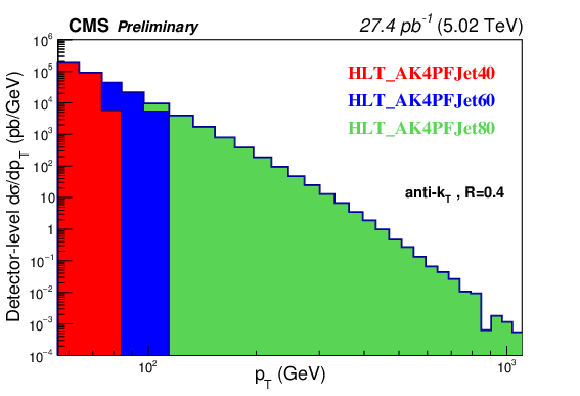
png pdf |
Figure 1:
The merged detector-level spectrum, with colors indicating which part of the spectrum comes from which trigger. The vertical axis is the number of observed jets divided by the product of effective luminosity and bin width. |
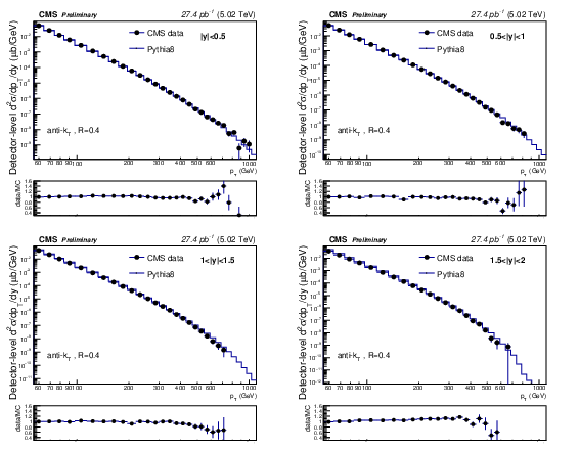
png pdf |
Figure 2:
The pT distribution at detector-level of the inclusive jet cross section, for the four rapidity bins, is shown for the data (points) and the PYTHIA 8 prediction (histogram) normalized to the total cross section of the data. The error bars show the statistical uncertainties on the data |
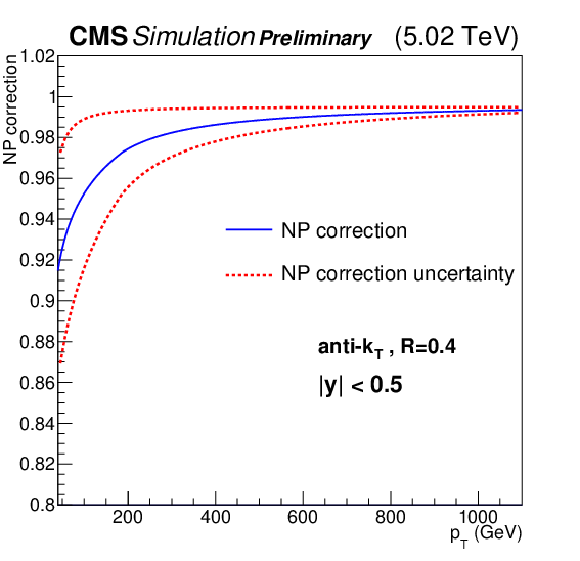
png pdf |
Figure 3:
The nonperturbative corrections to the fixed-order QCD calculation of inclusive-jet cross section, as a function of jet pT, for the most central rapidity bin. Dashed lines show the prediction of corrections using HERWIG 7 (lower line) and PYTHIA 8 (higher line). The central solid line shows the average NP correction used in this analysis, with an uncertainty defined by the extreme predictions. The NP corrections are similar in shape and value for the other rapidity bins. |

png pdf |
Figure 4:
The covariance matrices of the observed detector-level jet pT for the four rapidity bin. The color scale reports the square of the effective number of jets in data. |
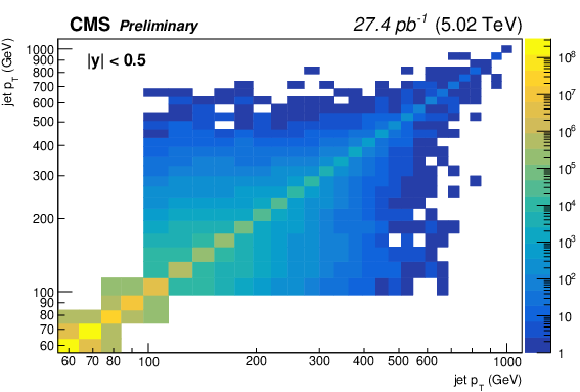
png pdf |
Figure 4-a:
The covariance matrices of the observed detector-level jet pT for the four rapidity bin. The color scale reports the square of the effective number of jets in data. |

png pdf |
Figure 4-b:
The covariance matrices of the observed detector-level jet pT for the four rapidity bin. The color scale reports the square of the effective number of jets in data. |

png pdf |
Figure 4-c:
The covariance matrices of the observed detector-level jet pT for the four rapidity bin. The color scale reports the square of the effective number of jets in data. |
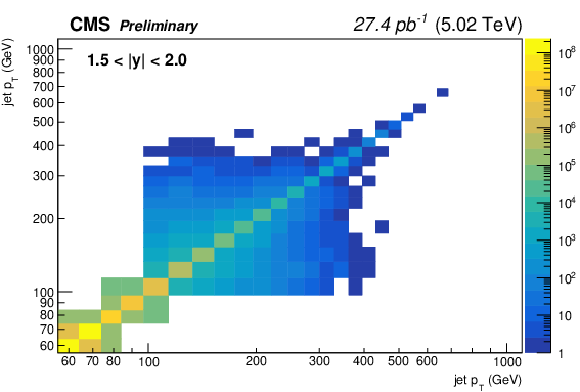
png pdf |
Figure 4-d:
The covariance matrices of the observed detector-level jet pT for the four rapidity bin. The color scale reports the square of the effective number of jets in data. |
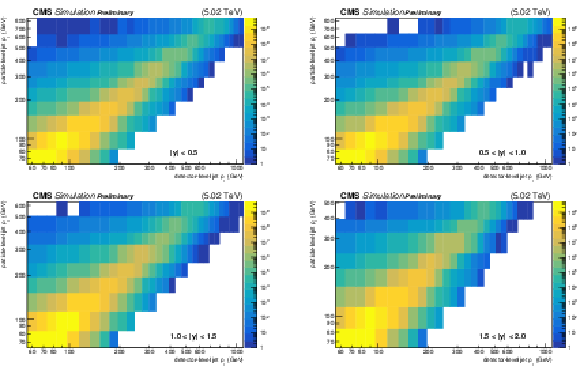
png pdf |
Figure 5:
The response matrices, the number of jets in a bin of detector-level pt that originate from jets in a bin of particle-level pT, for the four rapidity bins. The color scale reports the square of the number of toy-MC jets. |

png pdf |
Figure 5-a:
The response matrices, the number of jets in a bin of detector-level pt that originate from jets in a bin of particle-level pT, for the four rapidity bins. The color scale reports the square of the number of toy-MC jets. |

png pdf |
Figure 5-b:
The response matrices, the number of jets in a bin of detector-level pt that originate from jets in a bin of particle-level pT, for the four rapidity bins. The color scale reports the square of the number of toy-MC jets. |

png pdf |
Figure 5-c:
The response matrices, the number of jets in a bin of detector-level pt that originate from jets in a bin of particle-level pT, for the four rapidity bins. The color scale reports the square of the number of toy-MC jets. |

png pdf |
Figure 5-d:
The response matrices, the number of jets in a bin of detector-level pt that originate from jets in a bin of particle-level pT, for the four rapidity bins. The color scale reports the square of the number of toy-MC jets. |
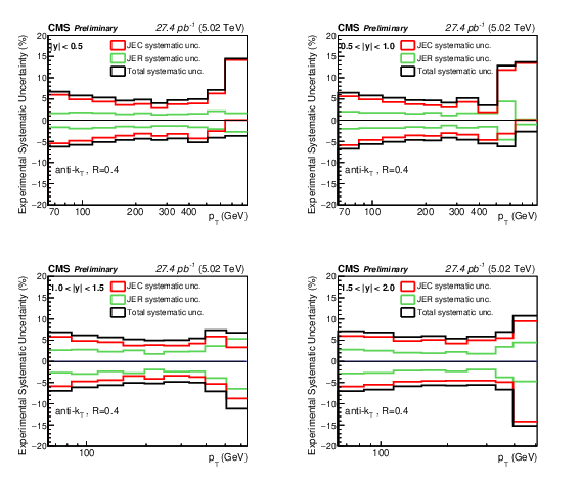
png pdf |
Figure 6:
JEC, JER, and total systematic uncertainties in unfolded cross sections as a function of transverse momentum and rapidity. The total systematic uncertainty includes also the luminosity, jet identification and trigger turn-on uncertainties. |
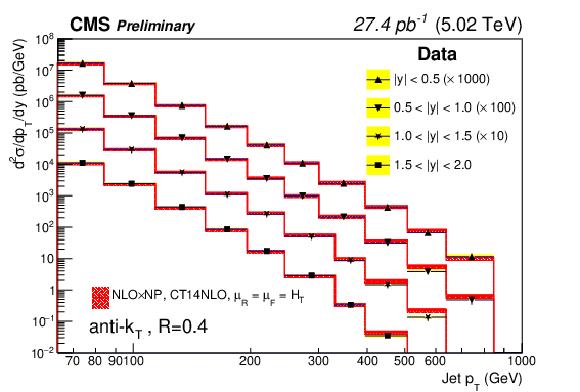
png pdf |
Figure 7:
The unfolded measured particle-level inclusive jet cross sections as a function of jet pT for the four rapidity regions, overlaid with the NLO perturbative QCD prediction, using the CT14nlo PDF set, with μR=μF=HT, and corrected for nonperturbative effects. The yellow band shows the experimental systematic uncertainty and the red band shows the theoretical systematic uncertainty. |

png pdf |
Figure 8:
Ratio of cross sections to the NLO theoretical prediction, using the CT14nlo PDF set, with μ=pT. The yellow band shows the total experimental uncertainty, the hashed red band shows the total theoretical uncertainty, and individual sources of theoretical uncertainty are shown with lines. |
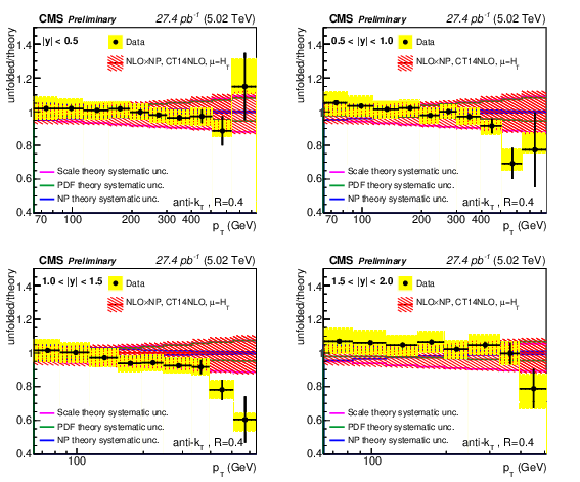
png pdf |
Figure 9:
Ratio of cross sections to the NLO theoretical prediction, using the CT14nlo PDF set, with μ=HT. The yellow band shows the total experimental uncertainty, the hashed red band shows the total theoretical uncertainty, and individual sources of theoretical uncertainty are shown with lines. |

png pdf |
Figure 10:
Ratio of cross sections to the NNLO theoretical prediction, using the CT14nnlo PDF set, with μ=HT. The yellow band shows the total experimental uncertainty, the hashed red band shows the total theoretical uncertainty, and individual sources of theoretical uncertainty are shown with lines. |

png pdf |
Figure 11:
Ratio of cross sections to the NNLO theoretical prediction, using the NNPDF31nnlo PDF set, with αS(MZ)=0.120 and μ=HT. The yellow band shows the total experimental uncertainty, the hashed red band shows the total theoretical uncertainty, and individual sources of theoretical uncertainty are shown with lines. |
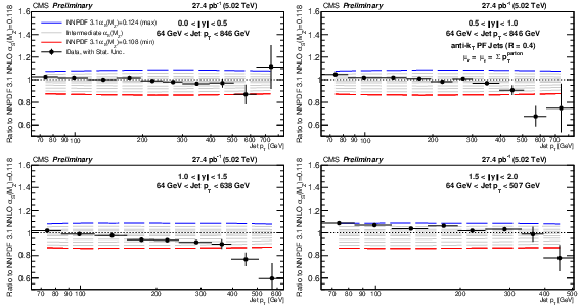
png pdf |
Figure 12:
The effect of αS variation. The NNLO theoretical cross section predictions using the NNPDF31nnlo PDF with μ=HT, calculated for different choices of αS, are divided by the benchmark NNLO prediction for αS=0.118 and the same choice of PDF set and renormalization and factorization scales. Also shown is the experimental unfolded measurement divided by the same benchmark prediction. |
| Tables | |
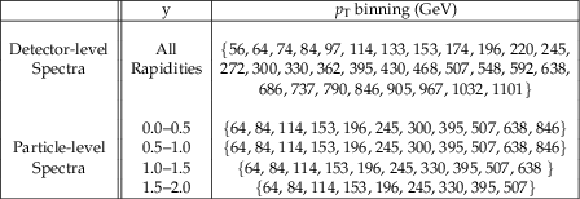
png pdf |
Table 1:
The pT binning for the detector-level spectra (all rapidities) and the particle-level spectra. |
| Summary |
| The measurement of the double-differential inclusive jet cross section in proton-proton collisions at 5.02 TeV has been presented. The measurements agree well with standard model predictions. The best agreement is found when the prediction is a NNLO QCD calculation with the renormalization and factorization scale choice μ=μR=μF=HT, and using the NNPDF31nnlo PDF set with αS(MZ)= 0.120. Going from the NLO to NNLO prediction reduces the scale systematic uncertainty at high pT, but increases it at low pT. The scale systematic uncertainty also increases when going from μ=pT to μ=HT in the NLO case. The effect of changing the scale is not very large for the NNLO calculation, and the scale systematic decreases at low-pT going from μ=pT to μ=HT. The uncertainty on the cross section due to PDFs is significantly reduced by choosing the NNPDF31nnlo family of PDF sets. For this PDF set, the choice of strong coupling constant αS(MZ)= 0.120 gives a cross section that is closer to the experimental results, compared to a benchmark of αS(MZ)= 0.118. The demonstrated sensitivity of the comparisons to the different values of αS could lead to a measurement of the strong coupling constant based on these results. |
| References | ||||
| 1 | AFS Collaboration | The jet cross section in pp interactions at √s= 45 GeV and its √s dependence | PLB 123 (1983) 133 | |
| 2 | AFS Collaboration | Direct evidence for the emergence of jets in events triggered on large transverse energy in pp collisions at √s=63GeV | PLB 118 (1982) 185 | |
| 3 | UA1 Collaboration | Hadronic jet production at the CERN proton-antiproton collider | PLB 132 (1983) 214 | |
| 4 | UA2 Collaboration | Measurement of the s dependence of jet production at the CERN pˉp collider | PLB 160 (1985) 349 | |
| 5 | UA1 Collaboration | Measurement of the inclusive jet cross section at the CERN pˉp collider | PLB 172 (1986) 461 | |
| 6 | UA2 Collaboration | Inclusive jet cross-section and a search for quark compositeness at the CERN collider | PLB 257 (1991) 232 | |
| 7 | UA1 Collaboration | Production of low transverse energy clusters in collisions at √s= 0.2-0.9 TeV and their interpretation in terms of QCD jets | NPB 309 (1988) 405 | |
| 8 | CDF Collaboration | Comparison of jet production in ˉpp collisions at √s= 546 GeV and 1800 GeV | PRL 70 (1993) 1376 | |
| 9 | A. A. Bhatti | Inclusive jet production at √s= 630 GeV and a test of scaling at CDF | 1996 Annual Divisional Meeting (DPF96) of the Division of Particles and Fields of the American Physical Society, Minnesota, MN, August 10-15 | |
| 10 | CDF Collaboration | Inclusive jet cross section in pˉp collisions at √s= 1.8 TeV | PRL 77 (1996) 438 | hep-ex/9601008 |
| 11 | D0 Collaboration | Inclusive jet production in pˉp collisions | PRL 86 (2001) 1707 | hep-ex/0011036 |
| 12 | D0 Collaboration | Measurement of the inclusive jet cross section using the using the kt algorithm in pˉp collisions at √s= 1.96 TeV | PRL 96 (2006) 122001 | hep-ex/0512062 |
| 13 | CDF Collaboration | Measurement of the inclusive jet cross section using the kt algorithm in pˉp collisions at √s= 1.96 TeV with the CDF II detector | PRD 75 (2007) 092006 | hep-ex/0701051 |
| 14 | CDF Collaboration | Measurement of the inclusive jet cross section at the fermilab tevatron pˉp collider using a cone-based jet algorithm | PRD 78 (2008) 052006 | 0807.2204 |
| 15 | D0 Collaboration | Measurement of the inclusive jet cross section in pˉp collisions at √s= 1.96 TeV | PRL 101 (2008) 062001 | 0802.2400 |
| 16 | D0 Collaboration | Measurement of the inclusive jet cross section in pˉp collisions at √s= 1.96 TeV | PRD 85 (2012) 052006 | 1110.3771 |
| 17 | ALICE Collaboration | Measurement of the inclusive differential jet cross section in pp collisions at √s= 2.76 TeV | PLB 722 (2013) 262 | 1301.3475 |
| 18 | ATLAS Collaboration | Measurement of the inclusive jet cross section in pp collisions at √s= 2.76 TeV and comparison to the inclusive jet cross-section at √s= 7 TeV using the ATLAS detector | EPJC 73 (2013) 2509 | 1304.4739 |
| 19 | CMS Collaboration | Measurement of the inclusive jet cross section in pp collisions at √s= 2.76 TeV | EPJC 76 (2016) 265 | CMS-SMP-14-017 1512.06212 |
| 20 | ATLAS Collaboration | Measurement of inclusive jet and dijet cross sections in proton-proton collisions at 7 TeV centre-of-mass energy with the ATLAS detector | EPJC 71 (2011) 1512 | 1009.5908 |
| 21 | CMS Collaboration | Measurement of the inclusive jet cross section in pp collisions at √s= 7 TeV | PRL 107 (2011) 132001 | CMS-QCD-10-011 1106.0208 |
| 22 | ATLAS Collaboration | Measurement of inclusive jet and dijet production in pp collisions at √s= 7 TeV using the ATLAS detector | PRD 86 (2012) 014022 | 1112.6297 |
| 23 | CMS Collaboration | Measurements of differential jet cross sections in proton proton collisions at √s= 7 TeV with the CMS detector | PRD 87 (2013) 112002 | CMS-QCD-11-004 1212.6660 |
| 24 | CMS Collaboration | Measurement of the ratio of inclusive jet cross sections using the anti-kt algorithm with radius parameters r= 0.5 and 0.7 in pp collisions at √s= 7 TeV | PRD 90 (2014) 072006 | CMS-SMP-13-002 1406.0324 |
| 25 | ATLAS Collaboration | Measurement of the inclusive jet cross section in proton-proton collisions at √s= 7 TeV using 4.5 fb−1 of data with the ATLAS detector | JHEP 02 (2015) 153 | 1410.8857 |
| 26 | CMS Collaboration | Constraints on parton distribution functions and extraction of the strong coupling constant from the inclusive jet cross section in pp collisions at √s= 7 TeV | EPJC 75 (2015) 288 | CMS-SMP-12-028 1410.6765 |
| 27 | CMS Collaboration | Measurement and QCD analysis of double-differential inclusive jet cross sections in pp collisions at √s= 8 TeV and ratios to 2.76 and 7 TeV | JHEP 03 (2017) 156 | CMS-SMP-14-001 1609.05331 |
| 28 | ATLAS Collaboration | Measurement of the inclusive jet cross-sections in proton-proton collisions at √s= 8 TeV with the ATLAS detector | JHEP 09 (2017) 20 | 1706.03192 |
| 29 | CMS Collaboration | Measurement of the double-differential inclusive jet cross section in proton-proton collisions at √s= 13 TeV | EPJC 76 (2016) 451 | CMS-SMP-15-007 1605.04436 |
| 30 | ATLAS Collaboration | Measurement of inclusive jet and dijet cross-sections in proton-proton collisions at √s= 13 TeV with the ATLAS detector | JHEP 05 (2018) 195 | 1711.02692 |
| 31 | CMS Collaboration | Dependence of inclusive jet production on the anti-kt distance parameter in pp collisions at √s= 13 TeV | JHEP 12 (2020) 82 | CMS-SMP-19-003 2005.05159 |
| 32 | WA97 Collaboration | Strangeness enhancement at mid-rapidity in PbPb collisions at 158 A GeV/c | PLB 449 (1999) 401 | |
| 33 | WA97 Collaboration | Transverse mass spectra of strange and multi--strange particles in PbPb collisions at 158 A GeV/ c | EPJC 14 (2000) 633 | |
| 34 | CMS Collaboration | Evidence for collectivity in pp collisions at the LHC | PLB 765 (2017) 193 | CMS-HIN-16-010 1606.06198 |
| 35 | D. d'Enterria | Jet quenching | in Springer Materials - The Landolt-B\"ornstein Database, R. Stock, ed., volume 23: Relativistic Heavy Ion Physics, p. 99 Springer | 0902.2011 |
| 36 | CMS Collaboration | Measurement of the splitting function in pp and pb-pb collisions at √sNN=5.02TeV | PRL 120 (2018) 142302 | CMS-HIN-16-006 1708.09429 |
| 37 | CMS Collaboration | Observation of medium-induced modifications of jet fragmentation in pb-pb collisions at √sNN=5.02TeV using isolated photon-tagged jets | PRL 121 (2018) 242301 | CMS-HIN-16-014 1801.04895 |
| 38 | ATLAS Collaboration | Observation of a centrality-dependent dijet asymmetry in lead-lead collisions at √sNN=2.76TeV with the ATLAS detector at the LHC | PRL 105 (2010) 252303 | 1011.6182 |
| 39 | CMS Collaboration | Jet momentum dependence of jet quenching in PbPb collisions at √sNN= 2.76 TeV | PLB 712 (2012) 176 | CMS-HIN-11-013 1202.5022 |
| 40 | CMS Collaboration | Jet energy scale and resolution in the CMS experiment in pp collisions at 8 TeV | JINST 12 (2017) P02014 | CMS-JME-13-004 1607.03663 |
| 41 | CMS Collaboration | The CMS trigger system | JINST 12 (2017) P01020 | CMS-TRG-12-001 1609.02366 |
| 42 | CMS Collaboration | Performance of the CMS Level-1 trigger in proton-proton collisions at √s= 13 TeV | JINST 15 (2020) P10017 | CMS-TRG-17-001 2006.10165 |
| 43 | CMS Collaboration | The CMS high level trigger | EPJC 46 (2006) 605 | 1403.1500 |
| 44 | CMS Collaboration | The CMS experiment at the CERN LHC | JINST 3 (2008) S08004 | CMS-00-001 |
| 45 | CMS Collaboration | Particle-flow reconstruction and global event description with the CMS detector | JINST 12 (2017) 10003 | CMS-PRF-14-001 1706.04965 |
| 46 | M. Cacciari, G. P. Salam, and G. Soyez | The anti-kt jet clustering algorithm | JHEP 04 (2008) 063 | 0802.1189 |
| 47 | M. Cacciari, G. P. Salam, and G. Soyez | FastJet user manual | EPJC 72 (2012) 1896 | 1111.6097 |
| 48 | CMS Collaboration | Determination of jet energy calibration and transverse momentum resolution in CMS | JINST 6 (2011) P11002 | 1107.4277 |
| 49 | T. Sj\ddotostrand et al. | An introduction to PYTHIA 8.2 | CPC 191 (2015) 159 | 1410.3012 |
| 50 | B. Andersson | The Lund model | Camb. Monogr. Part. Phys. NP Cosmol. 7 (1998) 1 | |
| 51 | NNPDF Collaboration | A determination of parton distributions with faithful uncertainty estimation | NPB 809 (2009) 1 | 0808.1231 |
| 52 | CMS Collaboration | Event generator tunes obtained from underlying event and multiparton scattering measurement | EPJC 76 (2016) 155 | CMS-GEN-14-001 1512.00815 |
| 53 | CMS Collaboration | Tuning PYTHIA 8.1: the Monash 2013 tune | EPJC 74 (2014) 3024 | 1404.5630 |
| 54 | CMS Collaboration | HERWIG 7.0/HERWIG++ 3.0 release note | EPJC 76 (2016) 196 | 1512.01178 |
| 55 | NNPDF Collaboration | Parton distributions from high-precision collider data | EPJC 77 (2017) 663 | 1706.00428 |
| 56 | UA1 Collaboration | A QCD model for jet fragmentation including soft gluon interference | NPB 238 (1984) 492 | |
| 57 | CMS Collaboration | Extraction and validation of a set of HERWIG 7 tunes from CMS underlying-event measurements | CMS-PAS-GEN-19-001 | |
| 58 | S. Agostinelli et al. | Geant4 -- a simulation toolkit | Nucl. Instrum. Methods Phys. Res. A 506 (2003) 250 | |
| 59 | Z. Nagy | Three jet cross-sections in hadron hadron collisions at next-to-leading order | PRL 88 (2002) 122003 | hep-ph/0110315 |
| 60 | Z. Nagy | Next-to-leading order calculation of three-jet observables in hadron hadron collisions | PRD 68 (2003) 094002 | hep-ph/0307268 |
| 61 | D. Britzger, K. Rabbertz, F. Stober, and M. Wobisch | New features in version 2 of the fastNLO project | in Proceedings, XX. International Workshop on Deep-Inelastic Scattering and Related Subjects (DIS 2012), p. 217 Bonn, Germany, March 26-30 | 1208.3641 |
| 62 | J. Currie et al. | Jet cross sections and transverse momentum distributions with NNLOJET | in Proceedings of Science, Loops and Legs in Quantum Field Theory 2018 | hep-ph/1801.06415 |
| 63 | J. Currie, E. W. N. Glover, and J. Pires | Next-to-next-to leading order QCD predictions for single jet inclusive production at the LHC | PRL 118 (2017) 072002 | hep-ph/1611.01460 |
| 64 | J. Currie et al. | Infrared sensitivity of single jet inclusive production at hadron colliders | JHEP 10 (2018) 155 | hep-ph/1807.03692 |
| 65 | D. Britzger et al. | Calculations for deep inelastic scattering using fast interpolation grid techniques at NNLO in QCD and the extraction of αs from HERA data | EPJC 79 (2019) 845 | hep-ph/1906.05303 |
| 66 | S. Dulat et al. | New parton distribution functions from a global analysis of quantum chromodynamics | PRD 93 (2016) 033006 | 1506.07443 |
| 67 | NNPDF Collaboration | Parton distributions for the LHC run II | JHEP 04 (2015) 040 | 1410.8849 |
| 68 | A. Buckley et al. | LHAPDF6: parton density access in the LHC precision era | EPJC 75 (2015) 132 | 1412.7420 |
| 69 | CMS Collaboration | First measurement of large area jet transverse momentum spectra in heavy-ion collisions | JHEP 05 (2021) 284 | CMS-HIN-18-014 2102.13080 |
| 70 | S. Schmitt | TUnfold: an algorithm for correcting migration effects in high energy physics | JINST 7 (2012) T10003 | 1205.6201 |

|
Compact Muon Solenoid LHC, CERN |

|

|

|

|

|

|